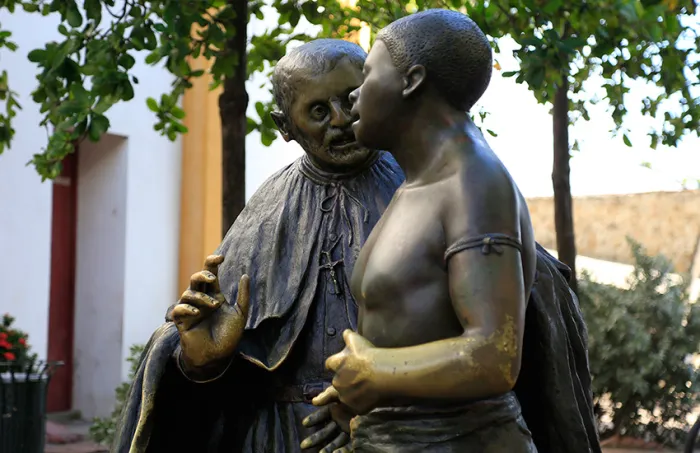Explorations of a living bridge to the past

The story of Goa’s St Francis Xavier can be rivaled by that of Colombia’s San Pedro Claver. Both were Jesuits from Spain, missionaries, and their mortal remains preserved in Goa and Cartagena, Colombia respectively. ALEXANDRE MONIZ BARBOSA visits Cartagena to find that the similarities are uncanny but veneration of the saints is far different.
The church bell rings at 6 pm calling the faithful to the service. This is not the normal weekday mass. In the Church of San Pedro Claver, within the walled city of Cartagena, Colombia, the novena to the Patron Saint of Colombia has begun. Inside the large church, not even half the pews have been filled up. There are about 100 people in the Church as the priest enters to the accompaniment of a hymn and makes the sign of the cross. The mass begins, tourists walk into the church and after a brief cursory look walk out. The mass ends and the congregation, made up mostly of white people, walks out.
If Goa, in St Francis Xavier has its own saint in residence, Cartagena has San Pedro Claver. Both were Jesuits, both hailed from Spain – Xavier from the Basque countryside and Claver from the Catalan. Both were missionaries, though they lived about 100 years apart. Xavier’s mortal remains are preserved in the Basilica of Bom Jesus in Old Goa, Claver’s in the high altar of the Church dedicated to him in the walled portion of the city of Cartagena. The similarities do not end there.
Uncannily, both Church facades have a dull look of exposed stone. Putting it into perspective, Fr Jorge Camacho, the Rector of the Sanctuary of San Pedro Claver and Jesuit Superior in Cartagena, says, “For the Jesuits, St Francisco Xavier was the great missionary in the East and San Pedro Claver was the great missionary in the West.”
The similarities, however, may end there. The contrast lies in the manner in which the saints are venerated in the churches where their remains are enshrined. If there were 100 people for the single novena mass in honour of San Pedro Claver in Cartagena, in Old Goa the novena masses that start at dawn and wind up only after the sun has set with a short break in the early afternoon, draw thousands on all nine days. On the feast day, close to 100,000 bow at the feet of their saint, upon whom they have informally bestowed the title ‘Goycho Saib’ or Lord of Goa. But if the people’s faith in the Lord of Goa is manifested by word and deed and participating in religious rites standing in long and winding queues to file past his sacred relics, the Patron Saint of Colombia gets few people falling at his feet, or in an act of faith touching the glass that encloses his relics.
Yet, early on a Monday evening in August, while tourists are milling around the historic centre of Cartagena and horse drawn carriages rattle along the streets, the scene changes. As you walk past the Plaza Aduana towards the Plaza San Pedro Claver the sounds emanating are neither that of church bells ringing nor the strains of choral music, the kind that one would normally expect from a Church. There are voices and they are loud and harsh. On the doorsteps of the Church of San Pedro Claver, the exposed stone façade of the church serving as the backdrop, a group of 16 to 20 year olds are demonstrating. They want change, they want the dominant class to listen to them, they want, Carlos one of the young protestors of the group Baru, tells us, equality. It’s a small group, all of them youth of African descent and they have had enough with being discriminated upon in their country. So they have decided to voice out loud their feelings. But, has the site for the demonstration been selected keeping in mind what the Patron Saint of the country, San Pedro Claver, stood for?
Fr Camacho, who is standing in the plaza watching as the youth demonstrate, is not sure they do. He stays there awhile, then turns and enters the cloister of the Church. I quickly follow him inside and begin a conversation on the saint and how relevant his work is even three centuries after his death. Outside the demonstration continues.
Among the youth there are those who do know of the Saint and a few who don’t. Daneis, a student of history and all of 20 years, says, “San Pedro Claver is a model to follow because he gave his life for the slaves and he did it with love.” She has just finished speaking on the microphone about the need for change. Greis Julio, a 16-year-old, says, “He was a priest who worked for more than 40 years to help slaves from Africa.” Both of them have got it right. In a city where the general perception, even among the clergymen, is that the African community, especially among those who profess the Catholic faith, has found new messiahs, the legend of San Pedro Claver appears to live on.
San Pedro Claver is perhaps the biggest contribution that the African community in Colombia gave to the country – their Patron Saint – who is also the Patron of Slaves. He did not come from Africa, he was not black, he was not a slave. It is his ministrations to the African slaves, kidnapped and shipped to Cartagena 400 years ago and sold to the highest bidder to work on the land, that led to the Jesuit priest from Spain being canonized by the Church.
The African slaves arrived in Cartagena chained at the neck and feet, having travelled at the bottom of the ship seeing no sunlight during the journey and fed every 24 hours with just half a plate of corn and a cup of water. They were met by Fr Pedro Clave, a white man, who gauged them not for their market value or their work abilities, but as humans. He brought them what little solace he could give those who were condemned to live and die as objects owned by another man.
The website of the Church of St Pedro Claver, where his remains are preserved, says, “Nobody loved this enslaved race more… For black descendants from Africa, this sacred place is a living bridge to their past, and a Shrine to their Saint.” But, that’s as far as the website goes and so too conversations on the saints relevance to the Cartagena’s African community today. There is a distinct reticence among the people of Cartagena in talking of their Patron Saint, perhaps even an indifference to his missionary work in the city. Centuries later, the still marginalized descendants of that enslaved race do not rush to the feet of their patron saint for comfort – whether spiritual or material.
Seated in the squares around the Church are women dressed in skirts made up of red, yellow and blue, the colours of the Colombian flag, and headscarves that are usually green, selling cut pieces of fruit. They come from the village of San Basilio de Palenque, about 70 km away. This is a settlement founded by an escaped slave that still exists has an all black population and is today recognized by UNESCO as a Masterpiece for Oral and Intangible Heritage of Humanity. San Pedro Claver would be their saint, but not many of the women are even aware of him. ‘I don’t know anything about him,” said Maria Perez, sitting behind her fruit at the Plaze Torre del Reloj. At the Plaza Bolivar, Maria Marquez said, “Saint? I don’t know anything about him. It doesn’t matter to me who he was. I am a realist.” A few feet away Anelina Cassiani finally has a positive answer. “He is connected to slavery. I go to the 6.45 mass in the morning. I believe in him as he is real.”
During his lifetime, Claver offered the slaves spiritual comfort. He baptized them. When they thirsted for freedom on Earth, what the Spaniard did was attempt to save them from eternal fire. He didn’t fight his fellow European white rulers and stop the slave trade. He only ministered to the spiritual needs of the Africans slaves that were brought to the new world, who today appear to have forgotten him.
Strangely, whether it be St Francis Xavier or San Pedro Claver, both saints find a larger following in the people who they perhaps didn’t think much of in their lifetimes. There is no explanation to the extraordinary association that the people of Goa have to St Francis Xavier. Of the 10 years he lived in Asia, he spent a mere 11 months in the former Portuguese colony, returning to the place from his various travels, as if to recharge his energy, only to sail away again. In his lifetime he viewed the Indians thorough the clouded perspective of XVI century Eurocentric views that judged them as ‘pagans’ whose souls had to be saved. Fr. Lucio de Veiga Coutinho, former editor of the Archdiocesan Bulletin agreed when he wrote, “It appears evident that he never came to truly understand and appreciate the Indian population whom he found little responsive to the Gospel. Instead, he was all praise and admiration for the Japanese people whom he extolled to the skies. Anyway, Goans did never particularly touch the chords of his otherwise extremely affectionate and sensitive heart.” In the case of Claver, it is the White Colombians, rather than the African slave descendants who he ministered to, who are more visible in his Church.
Yet, the Colombians today, the Jesuits in particular, take pride in stating that it was Claver who pioneered human rights when the world had not yet invented the term. Fr Camacho agrees that Claver was the “precursor of human rights”, the man who fought discrimination. “It is important that we work with the same spirit as San Pedro Claver to change the situation,” he says. “We have to understand him again and we are working of taking this forward,” says the priest.
For the Jesuit community in Cartagena filling up the pews in the sanctuary of San Pedro Claver that remain empty on most days would surely count as a success. If on the first day – August 31 – of the novena in preparation for the feast of the saint there were just about 100 persons participating in the mass, two days later on September 3, the numbers had not risen dramatically.
The devotion to San Pedro Claver in Cartagena may be diminishing, while in Goa the aura surrounding St Francis Xavier and the devotion to him continues to perpetuate, almost pulsating in Goan hearts. And it is not just the Catholics who go to the feet of St Francis Xavier. The Lord of Goa draws to his mausoleum people of all faiths who come with wounded hearts and souls, pouring out their troubles at his feet. Wax replicas of the afflicted body parts are offered to the Saint seeking healing. These are burnt and as the flames and smoke rise, they take the petitions to the Saint who, the people believe, will heal today’s wounds.
The wounds of the past, wrought through colonialism and its accompanying atrocities, no balm can soothe. Some of those remain festering or the youth of African descent would not be fighting for change and equality in the city of Cartagena. Over 300 years after Claver lived and died, the likes of Daneis and Greis, possibly descendants of persons who were shipped to Cartagena as slaves and baptized by Claver, are beginning the fight for equality and integration that has not yet come to the them. It could be through these young people that the living bridge to the past would turn visible as almost 400 years later these people of African descent still await their chance to become full partners in Colombian progress.






